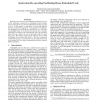Free Online Productivity Tools
i2Speak
i2Symbol
i2OCR
iTex2Img
iWeb2Print
iWeb2Shot
i2Type
iPdf2Split
iPdf2Merge
i2Bopomofo
i2Arabic
i2Style
i2Image
i2PDF
iLatex2Rtf
Sci2ools
DATE
2008
IEEE
2008
IEEE
Instruction Re-encoding Facilitating Dense Embedded Code
Reducing the code size of embedded applications is one of the important constraint in embedded system design. Code compression can provide substantial savings in terms of size. In this paper, we introduce a novel and efficient hardware-supported approach. Our approach investigates the benefits of re-encoding the unused bits (we call them re-encodable bits) in the instruction format for a specific application to improve the compression ratio. Re-encoding those bits may reduce the size of decoding table by more than 37%. We achieve compression ratios as low as 44% (including all overhead that incurs). We have conducted evaluations using a representative set of applications and have applied it to two major embedded processors, namely MIPS and ARM.
| Added | 29 May 2010 |
| Updated | 29 May 2010 |
| Type | Conference |
| Year | 2008 |
| Where | DATE |
| Authors | Talal Bonny, Jörg Henkel |
Comments (0)

